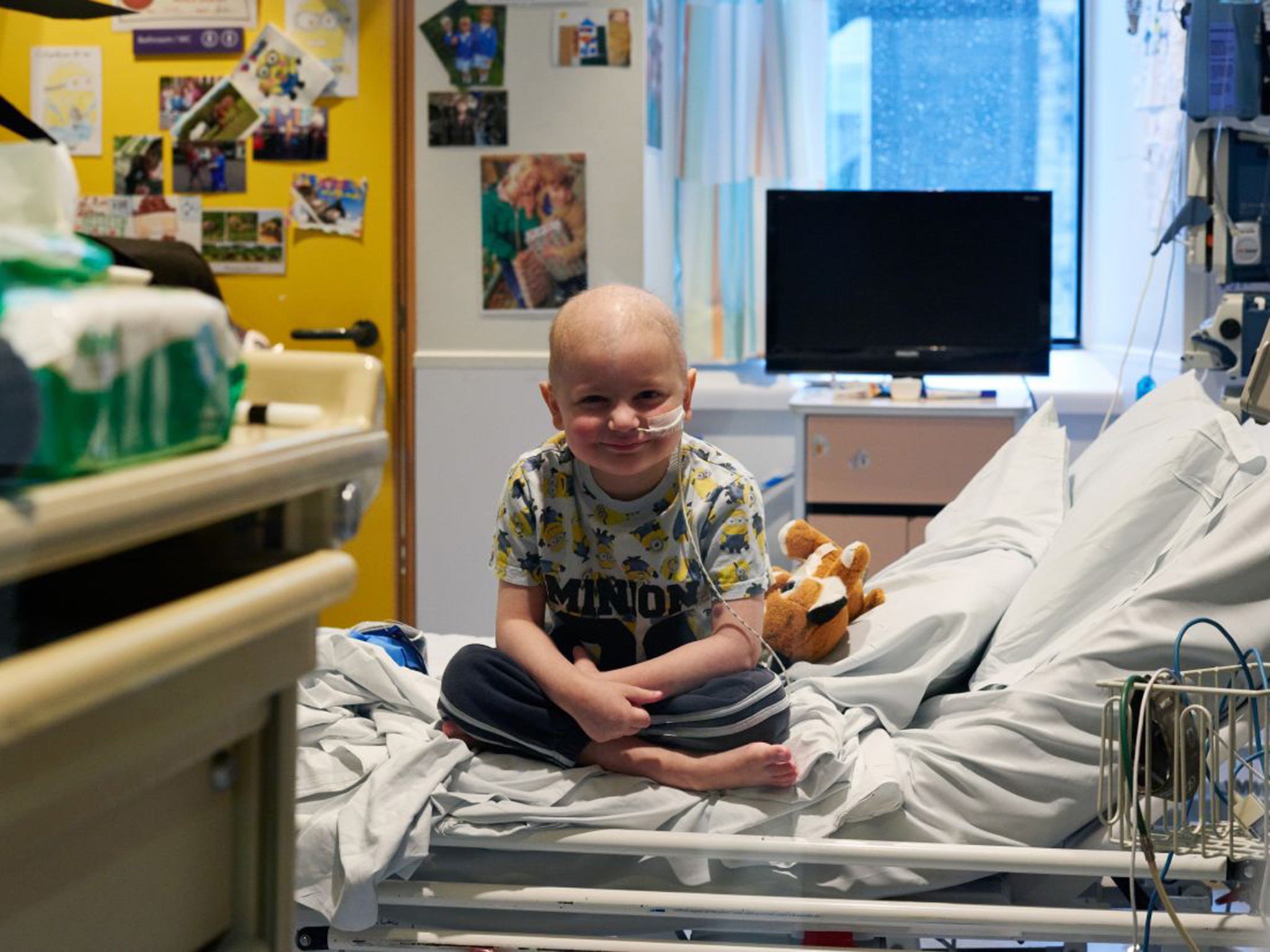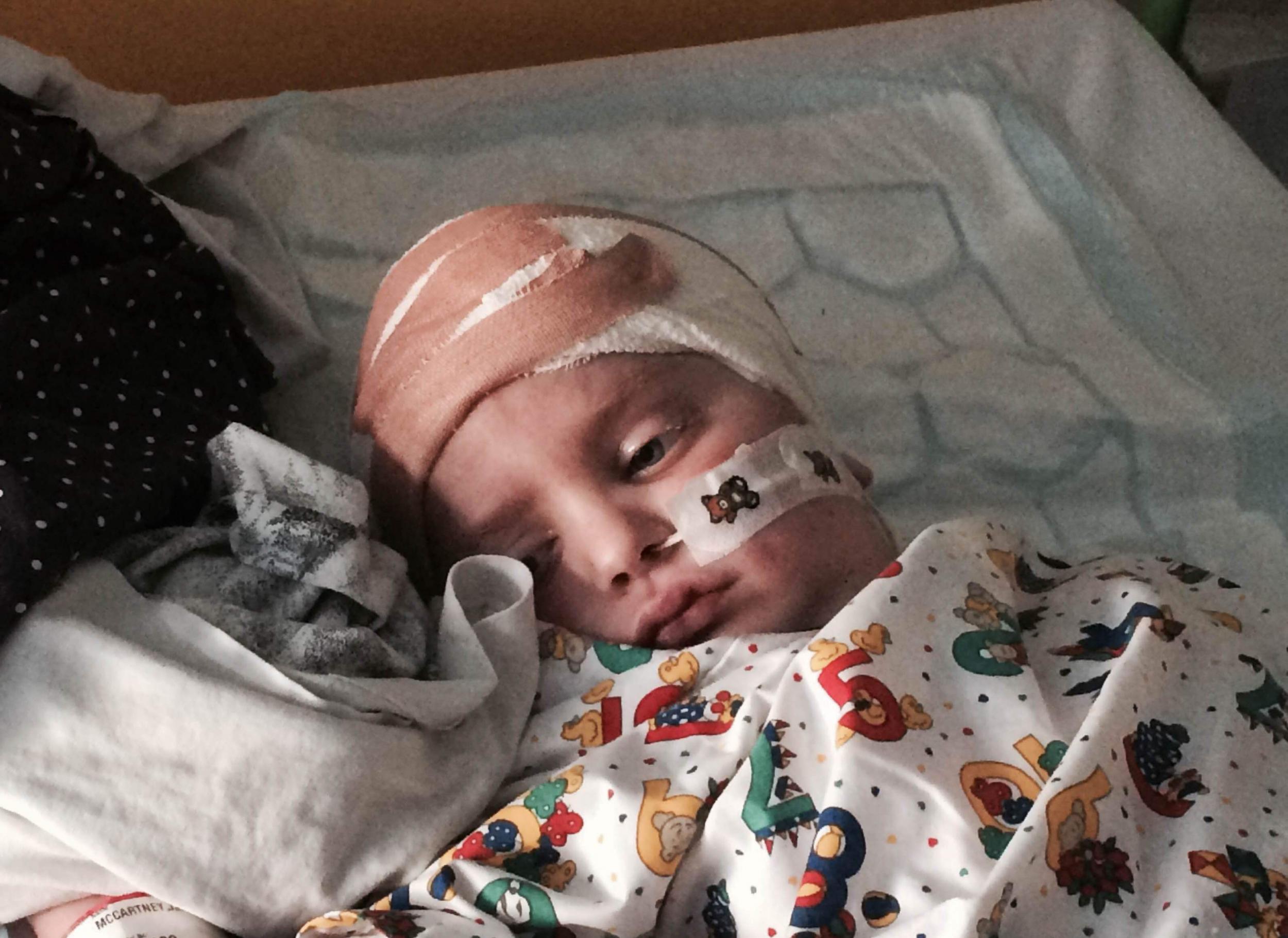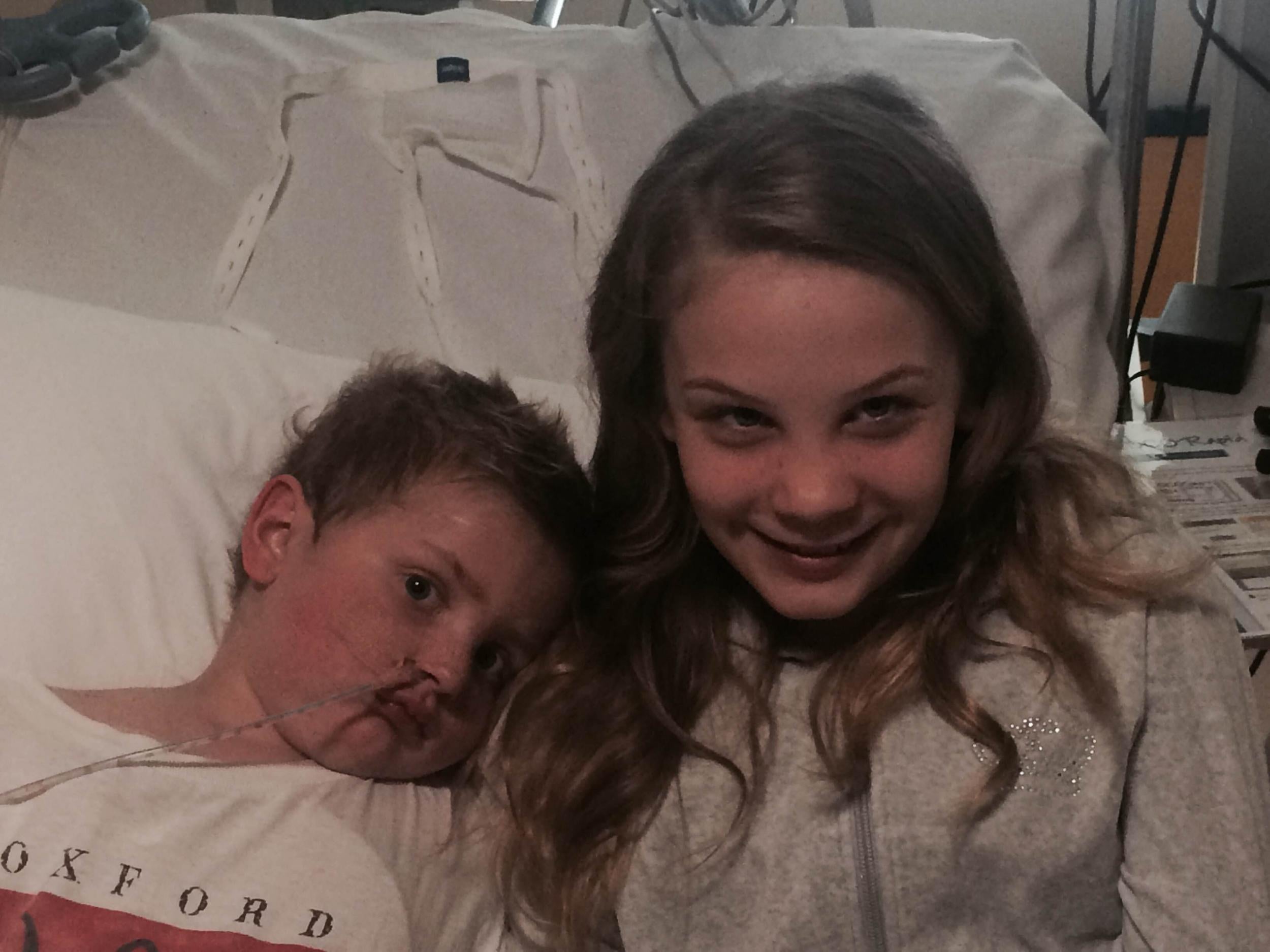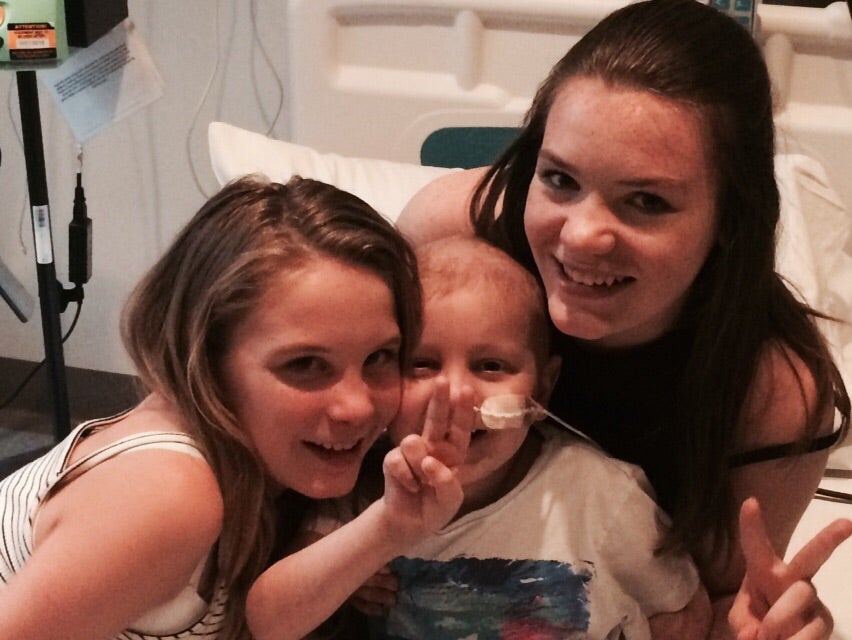James McCartney: The boy who beat the odds and bounced back to life
His illness is an extreme example of how complex the needs of the children treated at Great Ormond Street Hospital can be

Intensive care doctors usually say a child is “critically ill” when one of their organs begins to shut down, but this summer the medical team treating James McCartney battled to save his life as three of his major organs started “giving up” at the same time.
When six-year-old James was at his worst, his immune system was attacking his own heart, lungs and brain, causing near constant seizures and possible brain damage, and leaving him on a ventilator in intensive care, his heart struggling to beat.
His illness, an incredibly rare immune disorder, is an extreme example of how complex the needs of the children treated at GOSH – Great Ormond Street Hospital – can be, and illustrates how badly the hospital needs additional funding to research rare diseases and support complex patients such as James and their families.
Over the next few months, The Independent on Sunday’s Give to GOSH appeal will be raising money in partnership with The Independent, i, the London Evening Standard and the London Live television station. The appeal will support GOSH’s cutting-edge paediatric research as well as helping to fund the creation of a new 14-bed specialist unit to help children with heart failure live better qualities lives while they await transplant. It will also support the Louis Dundas Centre for Children’s Palliative Care, GOSH’s world-class centre dedicated to research, teaching and care for children with life-limiting illnesses.

Like many of the children who come to GOSH, James isn’t from London and the first few years of his life seemed normal. However, as he grew older, his parents Tony and Emma noticed that he was “struggling to shake off” colds and bugs, and by New Year’s Eve last year he was admitted to his local hospital in Epsom, his doctors suspecting leukaemia.
“It was a night without sleep,” his father Tony said, speaking last week outside his son’s isolation room which is decorated by Despicable Me stickers and dozens of carefully constructed Lego toys. “You think it’s the worst thing that could happen, but I soon realised it was something that he could survive. Doctors knew how to treat it.”
James did not have leukaemia, however. By mid-January he was transferred to GOSH, where his parents discovered he was actually suffering from haemophagocytic lymphohistiocytosis (HLH), an extremely rare and life-threatening condition that causes the immune system to become overactivated and damage the sufferer’s own tissues and organ, including bone marrow, the liver and the brain. His only long-term hope was chemotherapy and a risky bone-marrow transplant that his doctors gave him only a 50 per cent chance of surviving.
“Essentially, his immune system was knackered,” said Tony, who, like his wife, had to take a temporary break from his job as an accountant, to care for James. “It was absolutely terrifying as this condition is so rare that the doctors didn’t have much to go on.”
James was treated by Dr Kanchan Rao, a specialist in paediatric bone marrow transplant at the hospital. She said: “James has a very rare genetic condition, which means that his cells don’t repair well and after any kind of damage they behave, in simple terms, in a rowdy fashion. In his case attacking his own body, attacking his lymph nodes, his liver, his spleen and later on his brain and heart.”
During his treatment, James came close to death on “two or three” occasions, underwent a brain biopsy, had an infection of the hickman line that administered chemotherapy drugs, and suffered an episode “akin to a sudden heart attack”, while in June he suffered to a major setback during two days of continuous seizures. “He lost all movement down the left-hand side of his body. He couldn’t speak and didn’t recognise anything,” his father said, breaking down in tears. “Both of us were left thinking how brain damaged he could be.”

By August, though, James had “bounced back”, thanks to what his mother describes as “an incredible capability to recover”. Dr Rao was able to treat his illness with chemotherapy before overseeing an “extremely high-risk” bone marrow transplant. “James’s parents were distraught that their previously well, very bright six-year-old was suddenly very ill and dying. The whole family of two older sisters and mum and dad just fell apart,” she said.

James was not only treated by the doctors, nurses, psychologists and physiotherapists at GOSH. His family was supported by a host of volunteers and play workers, as well as the hospital’s chaplaincy service. “After a while, a case likes James’s almost becomes a mind game,” said Dr Rao. “There is only so much doctors and medication can do, and time and again we see that happy children who play and have positive families make that recovery that much quicker, especially when it comes to nutrition, exercise and walking.”
James is a playful child and last week for the first time he was able to leave his specialist isolation room, which protects his weak immune system, but his story is one of set-backs and crises, making him an example of why the Give to GOSH appeal is so important; he needed not just the support of charity-funded play workers and support stuff but also the fruits of decades of GOSH research that has made bone marrow transplants less dangerous for critically ill patients. The research is ongoing and needs help.

Donations from IoS readers will be doubled after George Osborne used the Autumn Statement last week to announce that the Treasury would match every pound raised by the Give to GOSH appeal.
Studies show that 30 per cent of HLH patients who have had a bone marrow transplant die within the first 100 days. But Thursday was the 100th day since James’s procedure and he is doing well, although he has had to overcome post-transplant complications, including bleeding from the intestines. He is making progress, and stands a good chance of being able to go home by Christmas.
Dr Rao said: “The hope is that the bone marrow transplant will cure him and the HLH risk will respond to infection in the future in an appropriate manner. He has got a few more steps before making a recovery to go home, but we know the transplant has worked.”
Who helped James live? A breakdown
The doctors
In addition to Dr Kanchan Rao, who first came to GOSH in 1999 as a registrar in haemato-oncology, 30 to 40 doctors, ranging from junior doctors to senior consultant and surgeons, have helped treat James during his stay at GOSH. These have included neurologists, cardiologists and intensive care specialists who have worked with James through his diagnosis to his recovery. “We are a team. It is never one doctor,” says Dr Rao.
The nursing team
At some stages of James’s treatment, including during long periods in intensive care, his nursing team has had to treat him with a carefully calibrated cocktail of 15 different types of drugs up to 66 times a day. “The nurses are fantastic,” says Dr Kanchan Rao. “They are highly trained in administering complex regimes of medication as well as all the others areas of care that James needs.”
The psychologists
The paediatric psychology department at GOSH is the largest in the UK, working not only with sick children but their parents and siblings too. Dr Kirsty Abbas, a clinical psychologist who worked with James when he was admitted to the intensive care unit in June, says: “Psychological support is particularly important on the intensive care unit as we know what an emotional and difficult time this can be for the child, their parents and siblings. As children are usually sedated and ventilated on intensive care, my work initially involves spending time with parents and siblings.”
Medical equipment
The complex nature of James’s illness resulted in his being treated with specialist kit by numerous teams of doctors and nursing staff during his stays at GOSH. The Independent on Sunday’s Give to GOSH appeal will help the hospital’s charitable arm fund about 150 pieces of essential equipment to help children like James. These include 100 IV parenteral nutrition pumps and a new cell processor to prepare sample for bone marrow transplants.
Accommodation
As with more than half the patients at GOSH James lives outside London, and his family has been able to make use of free-of-charge accommodation provided by the GOSH charity during his stay in hospital. Each week, GOSH helps to accommodate about 1,000 parents, and its accommodation has a more than 95 per cent occupancy rate for its family facilities. The Give to GOSH appeal will help to support the charity’s efforts to enable parents and siblings to continue to stay near their loved ones as they go through treatment.
Volunteers
GOSH relies on the help of more than 815 volunteers in 70 different roles across the hospital. They each carry out a minimum of four hours per week in roles ranging from emotional support to practical support. Last year, volunteers put in more than 177,000 hours of support. On Robin Ward, Julia Warren has been supporting the McCartney family. Emma says: “When James was really poorly, every now and again Julia would sit with him so that I could get a coffee or even do the laundry. It is great to have her here because you don’t want to leave your child alone for a moment.”
Chaplaincy
James’s mother Emma visits the chapel at GOSH twice a day, and has done throughout her son’s stay. “I find it very comforting and peaceful to sit and contemplate in a beautiful space,” she says. Jim Linthicum, senior chaplain, who also operates 24-hour on-call service for patients, family and staff, says: “The chapel is a place of peace and reflection, and we support all faiths. The most important thing is just being there for families.”
Play specialists
Emma and Tony say they couldn’t have got through their time on Robin Ward without the help of the GOSH play team, a group of 34 charity-funded play workers who help children relax, have fun and understand their treatments. Play worker Amy Crowley, who looks after the 10 patients on Robin Ward, including James, says: “James loves his Lego and we’ve made all sorts together. On Robin Ward it’s all about infection control. All the toys have to be brand new and everything stays in the child’s room. We can’t use it for another child because even the slightest crease in a toy could carry infection.”
School
Patients receive tuition at GOSH from the Department for Education-funded Children’s Hospital School which provides bedside lessons. James gets up an hour of tuition a day; his school is in regular contact with his parents and is considering setting up Skype sessions so he can stay in touch with his classmates.
If you Give to GOSH, your donation will be matched by the Government, doubling its amount. To donate go to: http://ind.pn/1Mydxqt
To find out more about our appeal and why we're supporting GOSH go to: http://ind.pn/1MycZkrNATE
Join our commenting forum
Join thought-provoking conversations, follow other Independent readers and see their replies
Comments